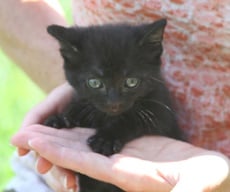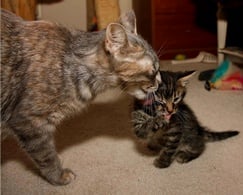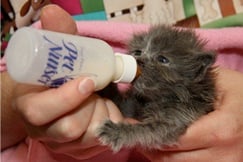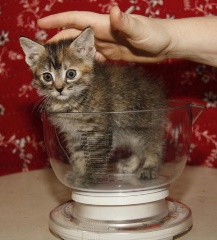
April 2013 by Laurie Peek, DVM
Audience: Executive Leadership, Foster Caregivers, Public, Shelter/Rescue Staff & Volunteers, Veterinary Team
 Orphaned kittens are special.
Orphaned kittens are special.
They are the most fragile of homeless animals, yet delightfully responsive to the loving care given to them. They bring with them hours of hard work, but also the reward of joy when they're finally adopted into a loving home.
And sadly, because their little lives can be so fragile, many shelters consider them too resource-intensive to raise. For that reason, orphaned kittens often make up the largest single group of animals euthanized at shelters.
It doesn't have to be that way. With new information on preventive care, successful shelter models showing the way forward and with the help of community foster caregivers, shelters can save the vast majority of their orphaned kittens and reap the rewards of seeing these little babies become part of an adopive family.
Getting Ready to Care for Kittens
As you venture into the exciting world of kitten care, you'll want to be prepared. Your goal is healthy, thriving kittens ready for adoption. However rewarding the outcome will be, to get them there you will be faced with numerous challenges.
For example, many of these kittens have come from less-than-ideal circumstances. They are likely to have been exposed to several infectious diseases, and are at high risk of becoming ill as well as becoming a source of infection for littermates or other cats. It is quite rare for an individual or group of orphaned kittens to transition and reach adoption uneventfully without complications from milk replacer, solid food, being weaned and spayed or neutered. However, by understanding the challenges, you can be ready with a plan of action to minimize problems when they arise.
Mortality Rates
The veterinary literature reports intimidating mortality rates for orphaned kittens up to 12 weeks of age, ranging from 15% to 40%.1 Deaths are rarely exhaustively investigated, but may be attributed to birth defects, trauma, infections and nutritional problems. Non-infectious causes are more common in the first few weeks of life, while infectious causes are more common at 3 to 4 weeks of age when the maternally derived antibodies from colostrum start to wane.2
The biggest determinants of natural kitten loss are low birth weight and poor growth rates. For dedicated caregivers, it can be heartbreaking and frustrating to lose kittens, but it is worth remembering that up to 60% of low-birth-weight kittens under natural conditions will fail to survive.3
There are also situations where caregiver error can contribute to kitten losses, including the failure to identify a problem soon enough or not providing adequate husbandry.3 Consequently, two of the very important steps in keeping orphaned kittens healthy are effective preventive medicine measures and caregiver education.
Preventive Health: Avoiding Disease
Preventive health for kittens can be broken into several components. The first component is promoting health through the avoidance of disease.
This is especially challenging for kittens coming into shelters and rescues. A 2002 study by Cave et al on kitten mortality in the United Kingdom showed that 55% of those kittens that died did so due to infectious disease, with 71% of those deaths due to viral disease. The same study also revealed that a significant proportion of kittens identified as dying of viral disease came from a shelter rather than a private home,4 confirming what many readers of this article will already know: Shelter kittens are more likely to suffer from infectious diseases.
Common infectious diseases seen in sheltered orphaned kittens include sepsis from bacterial infections, feline panleukopenia virus (also referred to as feline distemper or feline parvo), feline calicivirus, feline herpesvirus, feline infectious peritonitis, parasitic infections (such as roundworms, coccidia, giardia and fleas) as well as fungal infections (ringworm). Important predisposing factors for the development of infectious disease include:
- Exposure to infectious organisms;
- Lack of colostral antibodies;
- Stress from poor nutrition; and
- Poor environmental conditions such as temperature extremes.
 Keeping orphaned kittens in a protected area of the shelter away from other animals and keeping them separated by litters will help reduce the chance of exposure to infectious disease. Designating specific staff members who are well trained in disease transmission and whose only job is caring for these kittens will also help cut down on further inadvertent spread of disease by people.
Keeping orphaned kittens in a protected area of the shelter away from other animals and keeping them separated by litters will help reduce the chance of exposure to infectious disease. Designating specific staff members who are well trained in disease transmission and whose only job is caring for these kittens will also help cut down on further inadvertent spread of disease by people.
Getting the kittens out of the shelter and into a foster home is ideal. If kittens are cared for in a foster home, be sure the foster person houses the kittens in an area away from other animals and also practices good disease control, including lots of hand washing. The spread of infectious diseases can be bidirectional under these circumstances, and caregivers need to be aware of this.
Ideally, newborn kittens will have consumed colostrum immediately after birth providing them with significant immunity against infectious disease. However, the effectiveness of this protection is limited by the queen's level of immunity, so if the queen is not immune to panleukopenia, for example, then she will not be able to pass protective antibodies against panleukopenia along to her kittens via her colostrum. Similarly, the health and nutritional status of the queen will influence the quality and quantity of colostral antibodies that she can produce. Keep in mind these antibodies only offer passive or temporary protection and will start to diminish as the kitten begins to wean.
Once the maternal antibodies are gone, the kitten will be vulnerable to disease. Because of this risk, the 2006 American Association of Feline Practioners Feline Vaccine Advisory Panel Report recommended that kittens under the age of 8 weeks be housed in a clean foster home environment. If this is not possible, kittens entering high-risk shelters should receive a vaccine against panleukopenia as early as 4 weeks of age and be revaccinated every two weeks until they are 16 weeks old.
Other core vaccines such as feline herpesvirus and feline calicivurus can be started in kittens younger than 6 weeks of age.5 Shelter veterinary consultants are recommending beginning these core vaccines on admitted kittens at 4 weeks of age and revaccinating every 2 weeks until 16 to 20 weeks of age to help close gaps in vulnerability to these diseases.
Preventative Health: Meeting Nutritional and Environmental Needs
Caring for the nutritional needs of orphaned kittens is tricky. Neonatal kittens cannot digest milk if they are chilled, so you will want to make sure both the kitten and the milk are at the proper temperature before feeding.
- Neonatal kittens (kittens 0-2 weeks of age) body temperature should be 95-99° F
- Pre-weaned kittens (kittens 2-4 weeks of age) body temperature should be 97-101° F
- Formula should be warmed up to approximately queen's body temperature of 100° F
Diet changes can be upsetting to a kitten's digestive system, disrupting normal intestinal flora and resulting in diarrhea; so consistency can be critical. Consider daily prophylactic probiotics and diluting the milk 50:50 with a balanced electrolyte solution or water for the first few feedings. Try and avoid homemade diets whenever possible.
Overfeeding milk can also cause diarrhea, as well as regurgitation and aspiration of milk into the lungs, resulting in life-threatening pneumonia. Subsequently, a good understanding of kitten stomach capacity at varying ages is important, along with feeding smaller volumes more frequently.
Kittens are not able to regulate their own body temperature until they are about 2 weeks old. Supporting them with an appropriately set external heat source is therefore essential. The nesting area should be about 95° Fahrenheit and not too hot to the back of your hand when held for 2 minutes. As kittens age, the nesting temperature can gradually be reduced to about 75-80° Fahrenheit.
 Without the care and support of their mother, orphaned kitten nesting areas can become quickly soiled and damp. Keeping the nesting area, as well as the kitten, clean and dry is important to prevent chilling and spread of disease.
Without the care and support of their mother, orphaned kitten nesting areas can become quickly soiled and damp. Keeping the nesting area, as well as the kitten, clean and dry is important to prevent chilling and spread of disease.
There are many available resources that provide guidelines for housing and feeding. Housing needs will vary during different stages of growth. Daily weighing of kittens at the same time each day will most accurately determine feeding needs. For more information, please see the orphaned kitten webcast.
By avoiding overfeeding and by providing smaller quantities more frequently, many digestive disturbances can be prevented. A failure to thrive and gain weight can be an important factor in kitten morbidity and mortality, and by monitoring body weight daily, caregivers may more rapidly identify high risk or special needs kittens.
Most kittens can start to wean around 3 to 4 weeks of age. Weaning can be stressful on a kitten's delicate system, so it pays to be particularly watchful for problems such as diarrhea and follow recommended protocols around this time.
Preventive Health: Diagnosing and Treating Disease Early
The third component of preventive health is diagnosing and treating disease early. Working with a veterinarian to develop standardized orphaned kitten protocols is an excellent step in caring for these animals. These should include:
- An examination checklist.
- Disease screening tests.
- Intake procedures.
- Treatment recommendations.
- Housing and feeding guidelines.
As kittens are admitted (and hopefully housed quickly in a protected environment), getting a good history and performing a thorough physical exam will help guide the rest of each kitten's care. Try and gather as much information about the kittens as possible from those who found them. Example questions include:
- Where were they found?
- How long ago were they found?
- What happened to the mother?
- Was the mother vaccinated?
 The physical examination should be done systematically and include all of the body systems. Obtain an accurate weight and age estimation to guide nutritional and environmental needs.
The physical examination should be done systematically and include all of the body systems. Obtain an accurate weight and age estimation to guide nutritional and environmental needs.
For example, is the kitten alert and responsive with good muscle tone? Does he/she have a suckling and righting reflex?
Check the kitten's gums to make sure they are pink, moist and slippery. If they are tacky and deep red this may indicate dehydration or septicemia.
You can also assess hydration by checking the color of the kitten's urine. It should be dilute yellow.
Look for congenital defects such as a cleft pallet or umbilical hernia.
Carefully check the temperature to make sure the kitten isn't hypothermic and that the anal area is open and functioning properly. Neonatal kittens should measure about 96° Fahrenheit by rectal thermometer and gradually increase to about 100° Fahrenheit as they age.
Screening for disease should also include examining the kitten for fleas and other external skin conditions. If there is fecal material matted in the hair, or if the kitten has diarrhea, check a stool sample for parasites and treat accordingly. Shining a Wood's Lamp over the kitten's fur can serve as a helpful screen for ringworm. Look for any nasal or ocular discharge as tell-tale signs of upper respiratory disease.
If the kitten is old enough and warm enough, try feeding him or her a small amount of solid food to check his or her appetite. If the kitten is too young for solid food, feed a small amount of warm dilute milk replacer.
Intake procedures should include vaccination of kittens 4 weeks and older and deworming for common parasites. If there are health reasons for not vaccinating the kitten, then it is essential the kitten is protected from environmental disease exposure and isolated from other animals.
When an orphaned kitten is found to have a health issue, seeking veterinary attention sooner rather than later is crucial. If a veterinarian is not readily available, having established, easy to follow veterinarian-recommended treatment protocols is incredibly helpful. These should be developed, monitored and updated with the input of a veterinarian. See the resources in the related links section of Orphaned Kittens: How Saving the Tiniest Lives has the Biggest Impact webcast.
Orphaned kittens are not only vulnerable to infectious disease, but when they get sick, they rapidly become a risk to others. So, make sure your protocol addresses isolated housing care to protect against disease transmission.
Preventive Health: When Treatment and Management is Not Working
The fourth component of preventive health is recognizing when treatment and management of kittens is not working, and restoring the kitten to health as rapidly as possible. By addressing issues early, establishing and implementing treatment plans and staying on top of a kitten's response to therapy, you can minimize illness and resultant complications.
As mentioned above, weighing daily will help identify problems early and helps gauge a response to therapy. Another good tool to use is that of daily mini-exams to monitor progress. Keeping individual and detailed records of findings will help a shelter or individual caregiver track areas of improvement and areas that need continual attention.
Be honest about where problems are arising and areas that require attention or improvement. This feedback can be critical and in the long term lead to a sense of achievement and fulfillment for all.
Developing a treatment algorithm with a veterinarian and agreeing on the criteria under which the veterinarian is contacted should symptoms not improve or worsen will help caregivers know which direction to go when issues arise. An example of this is a kitten who develops diarrhea and gets treated according to an established treatment protocol, but in whom the diarrhea does not improve after a designated time-frame. Follow-up contact and communication between caregiver and veterinarian can help guide next steps, such as further diagnostics or an alternative treatment protocol, before clinical status deteriorates significantly.
Kitten-raising does involve dedication and attention to details, and there can be setbacks. By having and following a plan, and using methods that have worked for other orphaned kitten caregivers, you'll give these fragile lives their best chance at a long, happy life in a new home.
After reading this article, click here to take the quiz and receive a Certificate of Attendance!
References:
1. Hoskins JD. Veterinary Pediatrics: Dogs and Cats from Birth to Six Months, ed 2, WB Saunders Co, Philadelphia, 1995.
2. Bucheler J. Fading Kitten Syndrome and neonatal isoerythrolysis. Veterinary Clinics of North America: Small Animal Practice, July 1999, Vol 29, ed 4, p. 853-870.
3. Peterson ME, Kutzler MA. Small Animal Pediatrics, Elsevier Saunders, 2011, p. 67.
4. Cave TA, Thompson H, et al. Kitten mortality in the United Kingdom: a retrospective analysis of 274 histopathological examinations (1986-2000). Veterinary Record, October 26, 2002, p. 497-501.
5. American Association of Feline Practioners' Feline Vaccine Advisory Panel Report, Journal of the American Veterinary Medical Association, Vol 229, No. 9, November 1, 2006.
Additional Resource:
Lopate C. Management of Pregnant and Neonatal Dogs, Cats and Exotic Pets, Wiley-Blackwell, 2012.

Laurie Peek, DVM
Dr. Peek graduated from Cornell University College of Veterinary Medicine in 1996. She has been involved with Maddie's Fund® since its inception. As Maddie's Fund Director of Veterinary Programs, she has guided decisions on veterinary school grants and guidelines and advised on veterinary related issues. As Director of Maddie's Fund®, she has launched a series of live and on-demand webcasts on various shelter medicine topics designed to help shelter personnel address medical and behavioral problems in shelter dogs and cats, thereby helping them save more lives. Dr. Peek has also practiced small animal medicine and surgery and provides spay/neuter and adoption assistance to several animal welfare organizations in her community. She has been a foster parent to many kittens over the years.